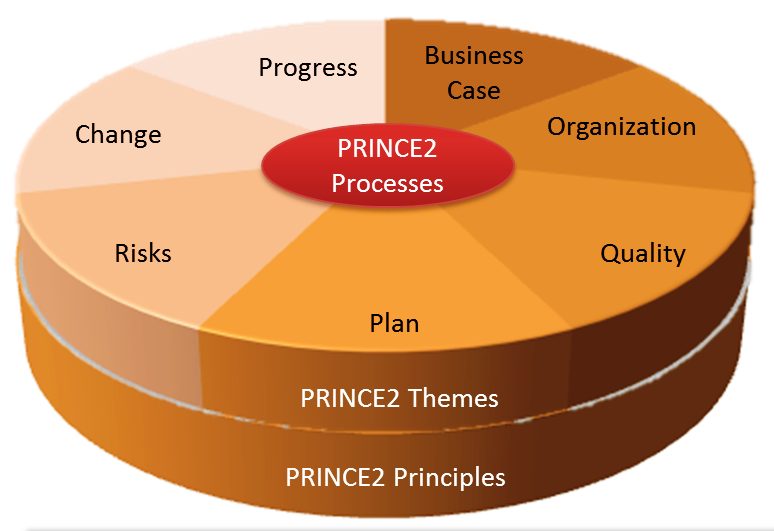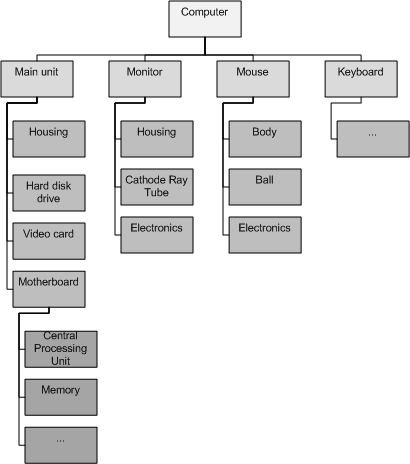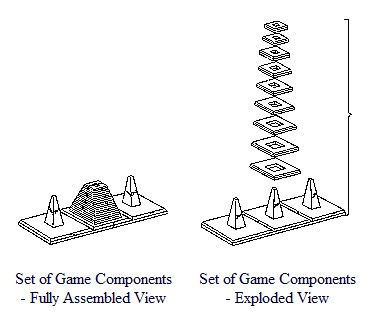|
Product Based Planning
Product-based planning is a fundamental part of the PRINCE2 approach to project management, and is a method of identifying all of the products (project deliverables) that make up or contribute to delivering the objectives of the project, and the associated work required to deliver them. The documents which define the Project itself are also considered Products. Overview ;Product breakdown structure : Product-based planning is intended to ensure that all of the necessary products are identified and captured, and begins by identifying a product breakdown structure which is then repeatedly refined until all of the requisite products are identified. The PBS is thus a hierarchical family tree of all the products and sub-products that comprise the final end-product. : It is important to understand that in this context the term 'product' includes intermediate documentary products that are essential to the work of delivering the project. In this sense the product breakdown structure is ... [...More Info...] [...Related Items...] OR: [Wikipedia] [Google] [Baidu] |
PRINCE2
PRINCE2 (PRojects IN Controlled Environments) is a structured project management method and practitioner certification programme. PRINCE2 emphasises dividing projects into manageable and controllable stages. It is adopted in many countries worldwide, including the UK, Western European countries, and Australia. PRINCE2 training is available in many languages. PRINCE2 was developed as a UK government standard for information systems projects. In July 2013, ownership of the rights to PRINCE2 were transferred from HM Cabinet Office to AXELOS Ltd, a joint venture by the Cabinet Office and Capita, with 49% and 51% stakes respectively. In 2021, PRINCE2 was transferred to PeopleCert during their acquisition of AXELOS. History PRINCE was derived from an earlier method called PROMPT II (Project Resource Organisation Management Planning Techniques). In 1989 the Central Computer and Telecommunications Agency (CCTA) adopted a version of PROMPT II as a UK Government standard for inform ... [...More Info...] [...Related Items...] OR: [Wikipedia] [Google] [Baidu] |
Project Management
Project management is the process of supervising the work of a Project team, team to achieve all project goals within the given constraints. This information is usually described in project initiation documentation, project documentation, created at the beginning of the development process. The primary constraints are Scope (project management), scope, time and budget. The secondary challenge is to operations research, optimize the Resource allocation, allocation of necessary inputs and apply them to meet predefined objectives. The objective of project management is to produce a complete project which complies with the client's objectives. In many cases, the objective of project management is also to shape or reform the client's brief to feasibly address the client's objectives. Once the client's objectives are established, they should influence all decisions made by other people involved in the project– for example, project managers, designers, contractors and subcontractors ... [...More Info...] [...Related Items...] OR: [Wikipedia] [Google] [Baidu] |
Product Breakdown Structure
{{more citations needed, date=January 2021 In project management under the PRINCE2 methodology, a product breakdown structure (PBS) is a tool for analysing, documenting and communicating the outcomes of a project, and forms part of the product based planning technique. The PBS provides "an exhaustive, hierarchical tree structure of deliverables that make up the project, arranged in whole-part relationship" (Haughey, 2015).Duncan Haughey. (2015) ‘Project Management Tools’, Project Smart. Available from: https://www.projectsmart.co.uk/project-management-tools.php Comparison with the work breakdown structure The PBS is identical in format to the work breakdown structure (WBS), but is a separate entity and is used at a different step in the planning process. The PBS precedes the WBS and focuses on cataloguing all the desired outputs (products) needed to achieve the goal of the project. This feeds into creation of the WBS, which identifies the tasks and activities required to deli ... [...More Info...] [...Related Items...] OR: [Wikipedia] [Google] [Baidu] |
Hierarchical
A hierarchy (from Greek: , from , 'president of sacred rites') is an arrangement of items (objects, names, values, categories, etc.) that are represented as being "above", "below", or "at the same level as" one another. Hierarchy is an important concept in a wide variety of fields, such as architecture, philosophy, design, mathematics, computer science, organizational theory, systems theory, systematic biology, and the social sciences (especially political science). A hierarchy can link entities either directly or indirectly, and either vertically or diagonally. The only direct links in a hierarchy, insofar as they are hierarchical, are to one's immediate superior or to one of one's subordinates, although a system that is largely hierarchical can also incorporate alternative hierarchies. Hierarchical links can extend "vertically" upwards or downwards via multiple links in the same direction, following a path. All parts of the hierarchy that are not linked vertically to one ano ... [...More Info...] [...Related Items...] OR: [Wikipedia] [Google] [Baidu] |
Exploded View
An exploded-view drawing is a diagram, picture, schematic or technical drawing of an object, that shows the relationship or order of assembly of various parts. It shows the components of an object slightly separated by distance, or suspended in surrounding space in the case of a three-dimensional exploded diagram. An object is represented as if there had been a small controlled explosion emanating from the middle of the object, causing the object's parts to be separated an equal distance away from their original locations. The exploded-view drawing is used in parts catalogs, assembly and maintenance manuals and other instructional material. The projection of an exploded view is usually shown from above and slightly in diagonal from the left or right side of the drawing. (See exploded-view drawing of a gear pump to the right: it is slightly from above and shown from the left side of the drawing in diagonal.) Overview An exploded-view drawing is a type of drawing, that sh ... [...More Info...] [...Related Items...] OR: [Wikipedia] [Google] [Baidu] |
Product Flow Diagram
The product flow diagram (PFD) is a representation of the order by which a sequence of products is created according to product-based planning principles. It is related to the product breakdown structure (PBS). The product flow diagram is a prescribed activity of the PRINCE2 project management methodology which mandates the use of product-based planning. Features Some important features of the product flow diagram (PFD) include: * The PFD is a planning aid, not an outcome of planning (like a PERT chart which looks similar), this is a common cause of confusion among the project managers * The PFD should contain all the products of the product breakdown structure (equivalent to a work breakdown structure) * The PFD should be kept as simple and high-level as possible for it to make sense (if additional detail is required, creating a supplementary, detailed product flow diagram can be useful) * All products should be 'linked into' the product flow diagram, even if it's only to the ... [...More Info...] [...Related Items...] OR: [Wikipedia] [Google] [Baidu] |
PERT
Pert or PERT may refer to: Ships * - see List of United States Navy ships: P * , a World War II corvette, originally HMS ''Nepeta'' * Pert (sidewheeler), ''Pert'' (sidewheeler), a 19th-century steamboat that operated in British Columbia, Canada Statistics * PERT distribution People * Pert (surname) * Pert Kelton (1907–1968), American actress PERT * Program evaluation and review technique, or PERT Chart, a planning method * Postsecondary Education Readiness Test, a placement test used by Florida high schools and colleges * Pancreatic enzymes (medication), Pancreatic enzyme replacement therapy or PERT is a treatment for exocrine pancreatic insufficiency. Other uses * Pert Plus, a brand of shampoo marketed in Australia and New Zealand as Pert * P e ^ , an expression to calculate the expected return from a Compound interest#Continuous compounding, continuously compounded investment given the principal, rate, and time See also * * Peart, a surname {{Disambiguation ... [...More Info...] [...Related Items...] OR: [Wikipedia] [Google] [Baidu] |
Critical Path Method
The critical path method (CPM), or critical path analysis (CPA), is an algorithm for schedule (project management), scheduling a set of project activities. A critical path is determined by identifying the longest stretch of dependent activities and measuring the time required to complete them from start to finish. It is commonly used in conjunction with the program evaluation and review technique (PERT). History The CPM is a project-modeling technique developed in the late 1950s by Morgan R. Walker of DuPont and James E. Kelley Jr. of Remington Rand. Kelley and Walker related their memories of the development of CPM in 1989. Kelley attributed the term "critical path" to the developers of the PERT, which was developed at about the same time by Booz Allen Hamilton and the U.S. Navy. The precursors of what came to be known as critical path were developed and put into practice by DuPont between 1940 and 1943 and contributed to the success of the Manhattan Project. Critical path ... [...More Info...] [...Related Items...] OR: [Wikipedia] [Google] [Baidu] |
Scope (project Management)
In project management Project management is the process of supervising the work of a Project team, team to achieve all project goals within the given constraints. This information is usually described in project initiation documentation, project documentation, crea ..., scope is the defined features and functions of a product, or the scope of work needed to finish a project. Scope involves getting information required to start a project, including the features the product needs to meet its stakeholders' requirements. Project scope is oriented towards the work required and methods needed, while product scope is more oriented toward functional requirements. If requirements are not completely defined and described and if there is no effective change control in a project, scope or requirement creep may ensue. Scope management is the process of defining, and managing the scope of a project to ensure that it stays on track, within budget, and meets the expectations of stakeholde ... [...More Info...] [...Related Items...] OR: [Wikipedia] [Google] [Baidu] |
Refrigerator
A refrigerator, commonly shortened to fridge, is a commercial and home appliance consisting of a thermal insulation, thermally insulated compartment and a heat pump (mechanical, electronic or chemical) that transfers heat from its inside to its external environment so that its inside is cooled to a temperature below the room temperature. Refrigeration is an essential Food preservation, food storage technique around the world. The low temperature reduces the reproduction rate of bacteria, so the refrigerator lowers the rate of Food spoilage, spoilage. A refrigerator maintains a temperature a few degrees above the freezing point of water. The optimal temperature range for perishable food storage is .Keep your fridge-freezer clean and ice-free ''BBC''. 30 April 2008 A freezer is a specialized refrigerator, or portion of a refrigerator, that maintains its contents’ temperature below the freezing point of water. The refrigerator replaced the icebox, which had been a common househ ... [...More Info...] [...Related Items...] OR: [Wikipedia] [Google] [Baidu] |
List Of Project Management Topics
The following outline is provided as an overview of and topical guide to project management: Project management – discipline of planning, organizing, securing, managing, leading, and controlling resources to achieve specific goals. A project is a temporary endeavor with a defined beginning and end (usually time-constrained, and often constrained by funding or deliverables), undertaken to meet unique goals and objectives, typically to bring about beneficial change or added value. The temporary nature of projects stands in contrast with ongoing business operations. What type of thing is project management? Project management can be described as all of the following: * Management – in business and human organization activity is simply the act of getting people together to accomplish desired goals. Management comprises planning, organizing, staffing, leading or directing, and controlling an organization (a group of one or more people or entities) or effort for the pu ... [...More Info...] [...Related Items...] OR: [Wikipedia] [Google] [Baidu] |
Managing Stage Boundaries
Managing Stage Boundaries is one of seven processes that make up PRINCE2, a systematic approach to project management developed by the UK's Office of Government Commerce and used widely in UK government and industry. The fundamental principle of Managing Stage Boundaries (SB) is to ensure that, at the end of each stage, the project stays focused on delivering business benefit. Description Managing Stage Boundaries (SB) is one of seven processes outlined by PRINCE2. It is a decision point in the continuity of the project, from which the project will be either continued as planned, adjusted or stopped. The process involves reviewing the current stage (is the business case still valid, should we proceed to the next stage), preparing for the next one, and selecting information which can be of use later in the project. The process is managed by the Project Manager, who informs the Project Board of the likelihood of success in attaining the project's business objective, project plan, t ... [...More Info...] [...Related Items...] OR: [Wikipedia] [Google] [Baidu] |





